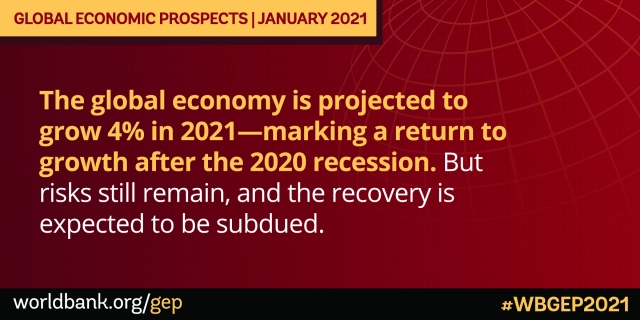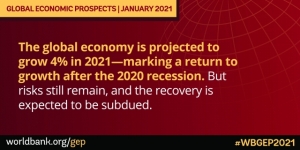World Bank Projects Global Economy to Expand by 4% in 2021
The global economy is expected to expand 4% in 2021, assuming an initial COVID-19 vaccine rollout becomes widespread throughout the year. A recovery, however, will likely be subdued, unless policymakers move decisively to tame the pandemic and implement investment-enhancing reforms, the World Bank says in its January 2021 Global Economic Prospects.
Although the global economy is growing again after a 4.3% contraction in 2020, the pandemic has caused a heavy toll of deaths and illness, plunged millions into poverty, and may depress economic activity and incomes for a prolonged period. Top near-term policy priorities are controlling the spread of COVID-19 and ensuring rapid and widespread vaccine deployment. To support economic recovery, authorities also need to facilitate a re-investment cycle aimed at sustainable growth that is less dependent on government debt.
“While the global economy appears to have entered a subdued recovery, policymakers face formidable challenges—in public health, debt management, budget policies, central banking and structural reforms—as they try to ensure that this still fragile global recovery gains traction and sets a foundation for robust growth,” said World Bank Group President David Malpass. “To overcome the impacts of the pandemic and counter the investment headwind, there needs to be a major push to improve business environments, increase labor and product market flexibility, and strengthen transparency and governance.”
The collapse in global economic activity in 2020 is estimated to have been slightly less severe than previously projected, mainly due to shallower contractions in advanced economies and a more robust recovery in China. In contrast, disruptions to activity in the majority of other emerging market and developing economies were more acute than expected.
“Financial fragilities in many of these countries, as the growth shock impacts vulnerable household and business balance sheets, will also need to be addressed,” Vice President and World Bank Group ChiefEconomist Carmen Reinhart said.
The near-term outlook remains highly uncertain, and different growth outcomes are still possible, as a section of the report details. A downside scenario in which infections continue to rise and the rollout of a vaccine is delayed could limit the global expansion to 1.6% in 2021. Meanwhile, in an upside scenario with successful pandemic control and a faster vaccination process, global growth could accelerate to nearly 5 percent.
In advanced economies, a nascent rebound stalled in the third quarter following a resurgence of infections, pointing to a slow and challenging recovery. U.S. GDP is forecast to expand 3.5% in 2021, after an estimated 3.6% contraction in 2020. In the euro area, output is anticipated to grow 3.6% this year, following a 7.4% decline in 2020. Activity in Japan, which shrank by 5.3% in the year just ended, is forecast to grow by 2.5% in 2021.
Aggregate GDP in emerging market and developing economies, including China, is expected to grow 5% in 2021, after a contraction of 2.6% in 2020. China’s economy is expected to expand by 7.9% this year following 2% growth last year. Excluding China, emerging market and developing economies are forecast to expand 3.4% in 2021 after a contraction of 5% in 2020. Among low-income economies, activity is projected to increase 3.3% in 2021, after a contraction of 0.9% in 2020.
Analytical sections of the latest Global Economic Prospects report examine how the pandemic has amplified risks around debt accumulation; how it could hold back growth over the long term absent concerted reform efforts; and what risks are associated with the use of asset purchase programs as a monetary policy tool in emerging market and developing economies.
“The pandemic has greatly exacerbated debt risks in emerging market and developing economies; weak growth prospects will likely further increase debt burdens and erode borrowers’ ability to service debt,” WorldBank Acting Vice President for Equitable Growth and Financial Institutions Ayhan Kose said.“The global community needs to act rapidly and forcefully to make sure the recent debt accumulation does not end with a string of debt crises. The developing world cannot afford another lost decade.”
As severe crises did in the past, the pandemic is expected to leave long-lasting adverse effects on global activity. It is likely to worsen the slowdown in global growth projected over the next decade due to underinvestment, underemployment, and labor force declines in many advanced economies. If history is any guide, the global economy is heading for a decade of growth disappointments unless policymakers put in place comprehensive reforms to improve the fundamental drivers of equitable and sustainable economic growth.
Policymakers need to continue to sustain the recovery, gradually shifting from income support to growth-enhancing policies. In the longer run, in emerging market and developing economies, policies to improve health and education services, digital infrastructure, climate resilience, and business and governance practices will help mitigate the economic damage caused by the pandemic, reduce poverty and advance shared prosperity. In the context of weak fiscal positions and elevated debt, institutional reforms to spur organic growth are particularly important. In the past, the growth dividends from reform efforts were recognized by investors in upgrades to their long-term growth expectations and increased investment flows.
Central banks in some emerging market and developing economies have employed asset purchase programs in response to pandemic-induced financial market pressures, in many cases for the first time. When targeted to market failures, these programs appear to have helped stabilize financial markets during the initial stages of the crisis. However, in economies where asset purchases continue to expand and are perceived to finance fiscal deficits, these programs may erode central bank operational independence, risk currency weakness that de-anchors inflation expectations, and increase worries about debt sustainability.
Download Global Economic Prospects
Global Economic Prospects: Europe and Central Asia
January 2021
Recent developments: The COVID-19 pandemic has generated a major health and economic crisis in theregion that has been compounded by social unrest and conflict. After stabilizing in mid-2020, the rate of cases sharply accelerated in the fourth quarter, forcing governments to maintain or reintroduce mitigation measures. Regional GDP is estimated to have contracted 2.9% last year, with nearly all economies in recession and roughly two-thirds expected to experience deeper contractions than during the global financial crisis. The economies hardest hit by the pandemic are those with strong trade or financial linkages to the euro area and those heavily dependent on services and tourism (Croatia, Kosovo, Montenegro).
The region’s emerging market and developing economies have experienced larger portfolio outflows than other economies, reflecting a loss of confidence and a flight to safety. Fiscal support packages have been announced in nearly all Europe and Central Asia economies. Despite these and other support measures, the pandemic is estimated to have triggered millions of job losses in the first three quarters of last year in Europe. Increases in the number of unemployed were particularly pronounced in Central Europe and Russia.
Outlook: The regional economy is forecast to expand only moderately in 2021, to 3.3%, as the resurgence ofCOVID-19 cases causes persistent disruptions to activity. The outlook is predicated on the distribution of an effective vaccine in early in 2021 in advanced economies and major emerging market and developing economies, including Russia, and later in the year for other countries. It also assumes that geopolitical tensions do not re-escalate in the region.
Growth in Russia, the region’s largest economy, is envisioned to pick up only modestly in 2021, to 2.6%, as the country grapples with a renewed acceleration in COVID-19 infections. Growth is expected to be supported by the rollout of a vaccine, a rise industrial commodity prices, and continuation of supportive policy measures. The Turkish economy, the second largest in the region, is projected to grow 4.5% in 2021 as a recovery in domestic demand takes hold and external demand picks up.
Growth in Central Europe is envisioned to firm this year to 3.6%, supported by recovery in trade, as activity rebounds in the euro area. Exceptional policy accommodation is expected to continue throughout 2021, including near-zero policy interest rates (Hungary, Poland). Growth in the Western Balkans is expected to recover to 3.5% in 2021, assuming that consumer and business confidence are restored as COVID-19 is brought under control and that political instability eases.
The sub-regional economy of Eastern Europe is projected to rise to a tepid 1.3% in 2021, reflecting challenges related to the pandemic, subdued domestic demand, and political tensions in Belarus. Growth in the South Caucasus is projected to rise 2.5% in 2021, as the shocks related to the pandemic and conflict dissipate, and as tourism recovers alongside improving consumer and business confidence. In Central Asia, growth is expected to recover to 3% this year, supported by a modest rise in commodity prices and foreign direct investment as the subregion deepens its integration with China’s Belt and Road Initiative.
Risks: Risks to the outlook are tilted markedly to the downside. The near-term growth outlook for the region isclouded by uncertainty around the recent surge in cases, which has contributed to social unrest in some countries, and the risk of an escalation of geopolitical tensions. The rise in COVID-19 cases in Europe and Central Asia could lead to more stringent restrictions and responses by households and firms.
|
Europe and Central Asia Country Forecasts |
|
|
|
|
|
|
|
(Annual percent change unless indicated otherwise) |
|
|
|
|
|
|
|
|
|
2018 |
2019 |
2020e |
2021f |
2022f |
|
GDP at market prices (2010 US$) |
|
|
|
|
|
|
|
Albania |
|
4.1 |
2.2 |
-6.7 |
5.1 |
4.4 |
|
Armenia |
|
5.2 |
7.6 |
-8.0 |
3.1 |
4.5 |
|
Azerbaijan |
|
1.5 |
2.2 |
-5.0 |
1.9 |
4.5 |
|
Belarus |
|
3.1 |
1.2 |
-1.6 |
-2.7 |
0.9 |
|
Bosnia and Herzegovina |
a |
3.7 |
2.7 |
-4.0 |
2.8 |
3.5 |
|
|
||||||
|
Bulgaria |
|
3.1 |
3.7 |
-5.1 |
3.3 |
3.7 |
|
Croatia |
|
2.7 |
2.9 |
-8.6 |
5.4 |
4.2 |
|
Georgia |
|
4.9 |
5.1 |
-6.0 |
4.0 |
6.0 |
|
Hungary |
|
5.1 |
4.6 |
-5.9 |
3.8 |
4.3 |
|
Kazakhstan |
|
4.1 |
4.5 |
-2.5 |
2.5 |
3.5 |
|
Kosovo |
|
3.8 |
4.2 |
-8.8 |
3.7 |
4.9 |
|
Kyrgyz Republic |
|
3.8 |
4.5 |
-8.0 |
3.8 |
4.5 |
|
Moldova |
|
4.3 |
3.6 |
-7.2 |
3.8 |
3.7 |
|
Montenegro |
|
5.1 |
4.1 |
-14.9 |
6.1 |
3.9 |
|
North Macedonia |
|
2.7 |
3.6 |
-5.1 |
3.6 |
3.5 |
|
Poland |
|
5.4 |
4.5 |
-3.4 |
3.5 |
4.3 |
|
Romania |
|
4.4 |
4.1 |
-5.0 |
3.5 |
4.1 |
|
Russian Federation |
|
2.5 |
1.3 |
-4.0 |
2.6 |
3.0 |
|
Serbia |
|
4.4 |
4.2 |
-2.0 |
3.1 |
3.4 |
|
Tajikistan |
|
7.3 |
7.5 |
2.2 |
3.5 |
5.5 |
|
Turkey |
|
3.0 |
0.9 |
0.5 |
4.5 |
5.0 |
|
Ukraine |
|
3.4 |
3.2 |
-5.5 |
3.0 |
3.1 |
|
Uzbekistan |
|
5.4 |
5.6 |
0.6 |
4.3 |
4.5 |
|
Source: World Bank. |
|
|
|
|
|
|
|
|
|
|
|
|
||











